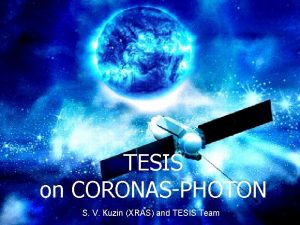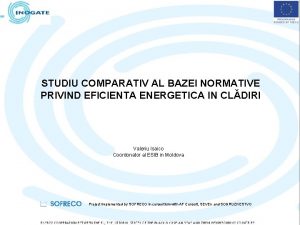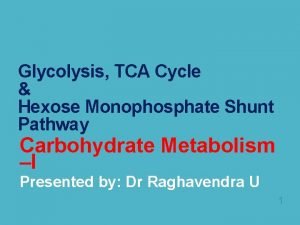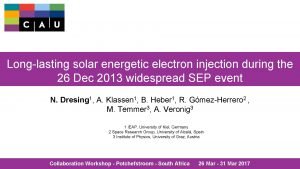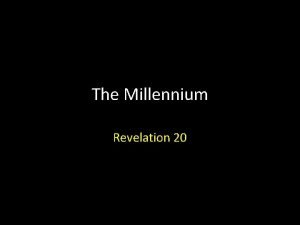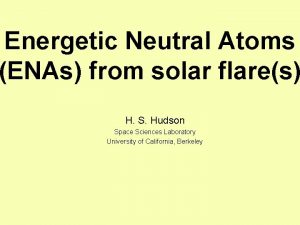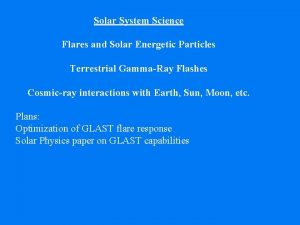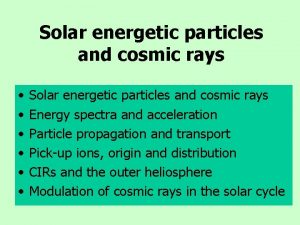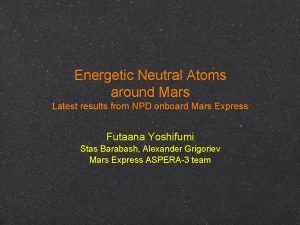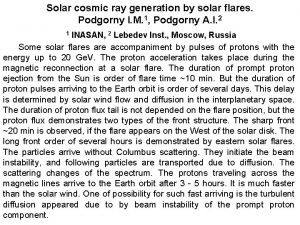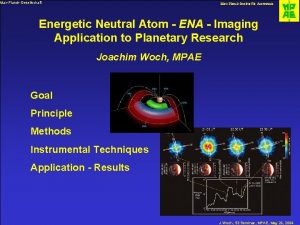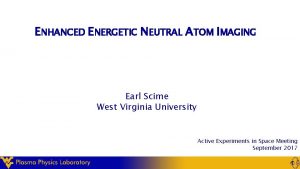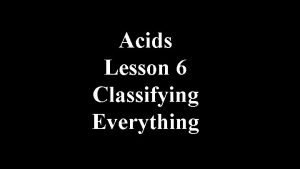Energetic Neutral Atoms ENAs from solar flares H















- Slides: 15

Energetic Neutral Atoms (ENAs) from solar flare(s) H. S. Hudson Space Sciences Laboratory University of California, Berkeley

Energetic Neutral Atoms* • An entirely new flare-associated “neutral particle” has appeared • The ENAs are the first guide to the “subcosmic rays” - particles neithermal nor detectable • If, that is, they can be associated with the flare g-ray sources. * See Mewaldt et al. (Ap. J 693, L 11, 2009) GSFC 6/24/2009

Mewaldt et al. Figures • The STEREO observations provide both spatial and temporal signatures that clearly identify the particles as hydrogen • The injection times closely match the GOES light curve of the flare GSFC 6/24/2009

Mewaldt et al. Figures (II) • The HET counts resemble those expected from neutron decay • The LET spectrum appears to steepen > 5 Me. V GSFC 6/24/2009

How many particles? • Mewaldt et al. estimate a total of 1. 8 x 1028 ENA particles (hydrogen atoms) assuming isotropic emission in a hemisphere • RHESSI g-ray observations imply a total of 1. 3 x 1031 protons above 30 Me. V • Assuming a spectral index of 3. 5, this implies a total of 2 x 1034 protons above 1. 6 Me. V The escape efficiency of 2 Me. V ENAs may be of order 10 -6 GSFC 6/24/2009

Whence flare ENAs? Neutralization and re-ionization on open field lines: Mikic & Lee, 2006 Neutralization and re-ionization on closed field lines: Dennis & Schwartz, 1989 http: //solarmuri. ssl. berkeley. edu/~hhudson/cartoons/ GSFC 6/24/2009

Whence flare ENAs? Neutralization and re-ionization on open field lines: Mikic & Lee, 2006 timing wrong Neutralization and re-ionization on closed field lines: Dennis & Schwartz, 1989 http: //solarmuri. ssl. berkeley. edu/~hhudson/cartoons/ GSFC 6/24/2009 tstrip ~ 120

Timing wrong for CME shock? 10 Rsun @ 3000 km/s GSFC 6/24/2009

Monte Carlo simulations • Neutral hydrogen and protons are alternative states of the same particle. Can multiple ionizations and neutralizations allow a few flare ENAs to originate from the flare g-ray sources in the deep corona? • If so, do the emergent ENAs retain any information about the spectrum, source structure, or time profile? • Everything is very complicated, so we are trying to extract answers via Monte Carlo simulations embodying enough of the physics GSFC 6/24/2009

Proton injected at 1. 6 Rsun @ 2 Me. V (example) GSFC 6/24/2009

What do we want to learn from the Monte Carlo model? • The escape efficiency as a function of injection height and other parameters • The spectrum of the escaping ENAs, ditto • The angular distribution of the emerging ENAs • The spatial structure of the apparent ENA source GSFC 6/24/2009

Some necessary physics Fe? • Charge exchange cross-sections (H-like and He-like only) Fe? • Charge exchange vs collisions • Impact ionization si = 2. 3 x 10 -17 Ep-0. 897 cm 2 (Barghouty, 2000) GSFC 6/24/2009

Notes on Monte Carlo model • The calculation includes ion flight with RK 4 tracing of the guiding center in a Schrijver-De. Rosa PFSS model of the coronal field (Hudson et al. , 2009) • Ion d. E/dx from Weaver & Westphal (2003); ion stripping from Barghouty (2000); charge-exchange on K-shell minor ions from Kuang (1992); ionization equilibrium from Mazzotta • The plots show successive ion and neutral flights (red) for a few particles with different fates GSFC 6/24/2009

Status of work • We have been trying to do this simulation for about one year • Senior research Hudson got to a certain point but could go no further • Brilliant student Chronopoulos may succeed in getting a proper code working before he goes off to graduate school • … GSFC 6/24/2009

Conclusions • The Mewaldt et al. (2009) result is one of the most important for flare high-energy physics in this century, since it opens a vast new parameter space • Interpretation is wide open at present. Our Monte Carlo model suggests that ENA escape from the flare g-ray sources may be feasible, but it is preliminary work • If the ENAs come from CME shock acceleration, we will need to revise our views of where this is happening GSFC 6/24/2009
 Tesis.xras
Tesis.xras Primary flare and secondary flare
Primary flare and secondary flare Periodic table regents
Periodic table regents Energetic self perception chart
Energetic self perception chart Model studiu energetic
Model studiu energetic Main function of tca cycle
Main function of tca cycle Casa viitorului
Casa viitorului Energetic particle
Energetic particle Colegiul energetic
Colegiul energetic Wholesalesolar.com
Wholesalesolar.com What is an inexhaustible source of energy
What is an inexhaustible source of energy Equinus contracture
Equinus contracture There is no neutral ground in the universe
There is no neutral ground in the universe Levels of diction
Levels of diction Risk neutral probability formula
Risk neutral probability formula Los esquemas acromáticos están basados en el uso del
Los esquemas acromáticos están basados en el uso del
